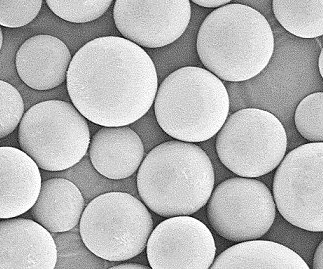Spherical polyamide particles developed for 3D printing
Specifically designed for additive manufacturing, Toray’s new spherical synthetic particles can be used to produce high-strength, heat-resistant 3D-printed parts.

Source | Toray
A new technique from Toray Industries Inc. (Tokyo, Japan) has been developed to more simply produce micro-level spherical particles of polyamide with high melting points, such as polyamide 6 and polyamide 66. Specifically designed for additive manufacturing, Toray’s new spherical synthetic particles can be used to produce high-strength, heat-resistant 3D-printed parts.
Polyamide particles, many of which are non-spherical in shape and have low melting point, such as polyamide 12, are used as materials in powder-based 3D printing. To create higher-quality 3D-printed objects, truly spherical particles with higher fluidity and uniform fillability are ideal, and higher melting points are required to build parts with high strength and heat resistance.
The drawback with conventional production techniques, according to Toray, has been the difficulty of creating truly spherical polyamide particles with the high melting points that needs handle with high-temperature conditions. Toray says it has created a new technique to produce truly spherical particles at the same time as the polyamide is polymerized from the monomer, and is able to handle polyamide materials at a range of melting points. Moreover, Toray says its technique makes it possible to control average particle sizes between several microns through several hundred microns, enabling creation of uniformly-sized particles.
Toray says it will continue to establish scale-up technique to apply the technology to automotive and other parts.
Related Content
-
AOC, Büfa expand distribution partnership
Through newly formed Büfa Composites Austria, customers in southeast Europe will have access to resins, gelcoats and auxillary materials.
-
UniSQ fire-retardant resins development bolster bushfire mitigation
The University of Southern Queensland has received funding to be used in the development of cost-effective composite resins to increase the resilience of wind turbine blades against bushfire exposure.
-
Plant tour: Daher Shap’in TechCenter and composites production plant, Saint-Aignan-de-Grandlieu, France
Co-located R&D and production advance OOA thermosets, thermoplastics, welding, recycling and digital technologies for faster processing and certification of lighter, more sustainable composites.

.jpg;width=70;height=70;mode=crop)













